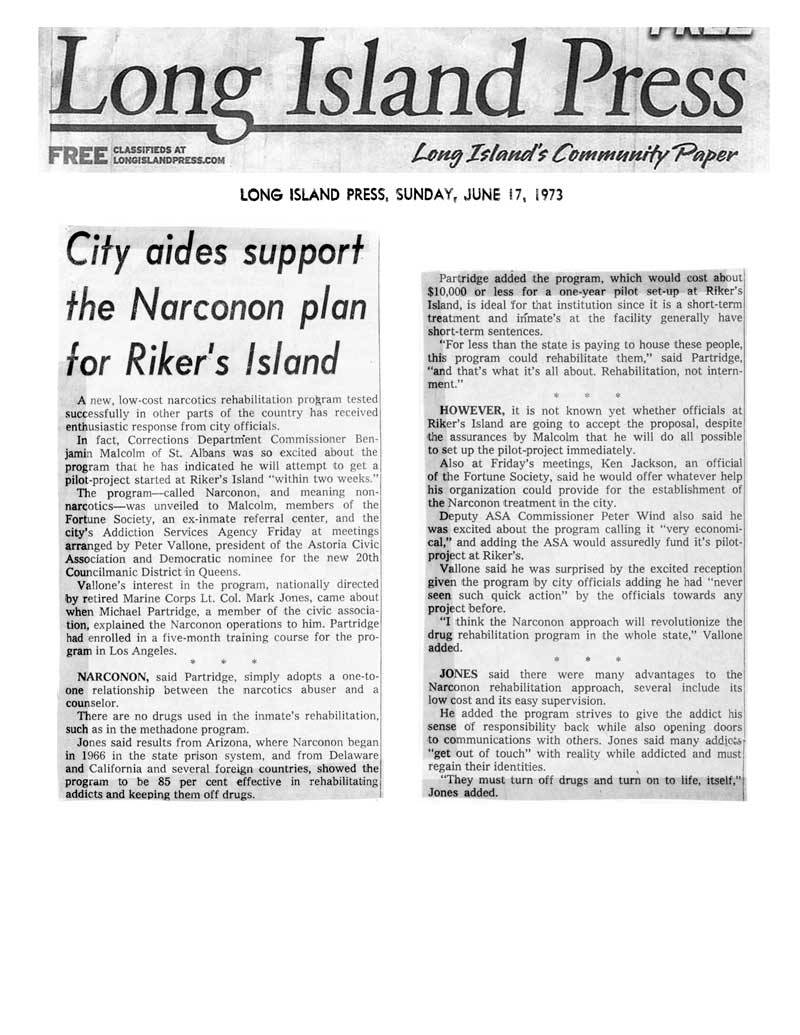New York City Aides Support the Narconon Plan for Rikers Island

A new, low-cost narcotics rehabilitation program tested successfully in other parts if the country has received enthusiastic response from city officials.
In fact, Corrections Department Commissioner Benjamin Malcolm of St. Albans was so excited about the program that he has indicated he will attempt to get a pilot-project started at Riker’s Island “within two weeks.”
The program—called Narconon, and meaning non-narcotics—was unveiled to Malcolm, members of the Fortune Society, an ex-inmate referral center, and the city’s Addiction Services Agency Friday at meetings arranged by Peter Vallone, president of the Astoria Civic Association and Democratic nominee for the new 20th Councilmanic District in Queens.
Vallone’s interest in the program, nationally directed by retired Marine Corps Lt. Col. Mark Jones, came about when Michael Partridge, a member of the civic association, explained the Narconon operations to him. Partridge had enrolled in a five-month training countriesse for the program in Los Angeles.
NARCONON, said Partridge, simply adopts a one-to-one relationship between the narcotics abuser and a counselor.
There are no drugs used in the inmate’s rehabilitation, such as the methadone program.
Jones said results from Arizona, where Narconon began in 1966 in the state prison system, and from Delaware and California and several foreign countries, showed the program to be 85 per cent effective in rehabilitating addicts and keeping them off drugs.
Partridge added the program, which would cost about $10,000 or less for one-year pilot set-up at Riker’s Island, is ideal for that institution since it is a short-term treatment and inmates at the facility generally have short-term sentences.
“For less than the state is paying to house these people, this program could rehabilitate them,” said Partridge, “and that’s what it’s all about. Rehabilitation, not internment.”
HOWEVER, it is not known yet whether officials at Riker’s Island are going to accept the proposal, despite the assurances by Malcolm that he will do all possible to set up the pilot-project immediately.
Also at Friday’s meetings, Ken Jackson, an official of the Fortune Society, said he would offer whatever help his organization could provide for the establishment of the Narconon treatment in the city.
Deputy ASA Commissioner Peter Wind also said he was excited about the program calling it “very economical,” and adding the ASA would assuredly fund it’s pilot-project at Riker’s.
Vallone said he was surprised by the excited reception given to the program by city officials adding he had “never seen such quick action” by the officials towards any project before.
“I think the Narconon approach will revolutionize the drug rehabilitation program in the whole state,” Vallone added.
JONES said there were many advantages to the Narconon rehabilitation approach, several include its low cost and its easy supervision.
He added the program strives to give the addict his sense of responsibility back while also opening doors to communications with others. Jones said many addicts “get out of touch” with reality while addicted and must regain their identities.
“They must turn off drugs and turn on to life, itself,” Jones added.
Other Articles from 1973: